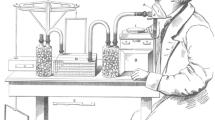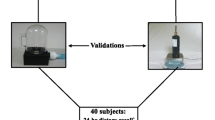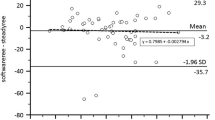Abstract
The purpose of this study was to compare oxygen uptake (\(\dot V{\text{O}}_{\text{2}} \)) values collected with a new portable indirect calorimeter (AeroSport TEEM 100 Metabolic Analysis System) against a more traditional large calorimeter system that has been reported to be valid and reliable (SensorMedics 2900 Metabolic Measurement Cart). Minute ventilations ranging from rest up to heavy exercise were compared with simultaneous measurements from a 120-1 Tissot gasometer. Each of the three TEEM 100 pneumotachs were tested. Three hundred and sixty-one separate ventilation tests were performed using the low-flow, medium-flow, and high-flow heads of the portable calorimeter. For each of the pneumotachs, the correlation between the portable calorimeter values and the gasometer values exceededr = 0.94. The standard error of estimate for the low-, medium- and high-flow pneumotach were 5.96, 4.89 and 9.0%, respectively, expressed relative to the mean gasometer value. Simultaneous measurements of\(\dot V{\text{O}}_{\text{2}} \) using the portable calorimeter and the SensorMedics 2900 unit were compared during rest and at work rates starting at zero watts, increasing by 25 W to 150 W. Each work rate was of 4 min duration. The average of data from minutes 3 and 4 were used in all analyses. There was very close agreement between the two metabolic measurement systems. Except at the 100-W work rate, where the\(\dot V{\text{O}}_{\text{2}} \) difference was small (3.9%), yet statistically significant, all of the other differences in\(\dot V{\text{O}}_{\text{2}} \) were small and non-significant. The scatter plot of\(\dot V{\text{O}}_{\text{2}} \) for the SensorMedics versus the portable Aero-Sport calorimeter revealed close agreement; the correlation wasr = 0.96, (SEE = 3.95%). It was concluded that the AeroSport TEEM 100 portable calorimeter system produces valid data at rest and at low to moderate work rates compared to a criterion, large system.
Similar content being viewed by others
References
AeroSport (1993) TEEM 100 Total Energy Expenditure Measurement operators manual. Ann Arbor, Mich, USA
Atwater WO, Rosa EB (1899) Description of a new respiration calorimeter and experiments on the conservation of energy in the human body. U.S. Department of Agriculture Off. Exp. Sta. Bull 63
Consolazio CF, Johnson RE, Pecora LJ (1963) Physiological measurements of metabolic functions in man. McGraw-Hill, New York
Haldane JS (1892) A new form of apparatus for measuring the respiratory exchange of animals. J Physiol (London) 13:419–430
Kane J, Jones N, Nones TE, Sutton B (1983) An evaluation of the Beckman Metabolic Measurement Cart. Beckman reprint no. 0323
Kannagi T (1983) An evaluation of the Beckman Metabolic Cart for measuring ventilation and aerobic requirements during exercise. J Cardiac Rehabil 3:38
Kleiber M (1975) The fire of life: an introduction to animal energetics, 2nd ed. Krieger, Huntington, N. Y.
Lavoisier AL, de La Place RS (1789) Memoire sur la chaleur; memoires de l'Academie Royale. Reprinted in Ostwald's Klassiker, no. 40, Leipzig, 1892
Lothian F, Farrally MR, Mahoney C (1993) Validity and reliability of the Cosmed K2 to measure oxygen uptake. Can J Appl Physiol 18:197–206
McArdle WD, Katch FI, Katch VL (1991) Exercise physiology: energy, nutrition, and human performance, 3rd edn. Lea and Febiger, Philadelphia
McNeill G, Cox MD, Rivers JPW (1987) The Oxylog oxygen consumption meter: a portable device for measurement of energy expenditure. Am J Clin Nutr 45:1415–9
Norton AC (1980) Portable equipment for gas exchange. In: Assessment of energy metabolism in health and disease. Ross Laboratories, Columbus, Ohio
Peel C, Utsey C (1993) Oxygen consumption using the K2 telemetry system and a metabolic cart. Med Sci Sports Exerc 25:396–400
Scholander PF (1947) Analyzer for accurate estimation of respiratory gases in one-half cubic centimeter samples. J Biol Chem 167:235–250
SensorMedics (1991) 2900 Metabolic Cart operator's manual, part no. 767257. Los Angeles, Calif.
Webb P, Troutman SJ (1970) An instrument for continuous measurement of oxygen consumption. J Appl Physiol 28:876
Wilmore JH, Costill DL (1974) Semiautomated systems approach to the assessment of oxygen uptake during exercise. J Appl Physiol 36:618
Wilmore JH, Davis JA, Norton AC (1976) An automated system for assessing metabolic and respiratory function during exercise. J Appl Physiol 40:619
Author information
Authors and Affiliations
Rights and permissions
About this article
Cite this article
Novitsky, S., Segal, K.R., Chatr-Aryamontri, B. et al. Validity of a new portable indirect calorimeter: the AeroSport TEEM 100. Europ. J. Appl. Physiol. 70, 462–467 (1995). https://doi.org/10.1007/BF00618499
Accepted:
Issue Date:
DOI: https://doi.org/10.1007/BF00618499




